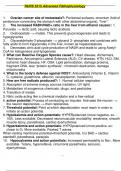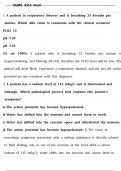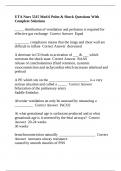NURS 5315 (NURS5315)
University Of Texas - Arlington
All 193 results
Sort by
Newest nurs 5315 advanced pathophysiology 345 exam questions and correct answers (2025
NURS 5315 ADVANCED PATHOPHYSIOLOGY Final EXAM 2024 Questions and Answers Latest (2024 / 2025) (Verified Answers)
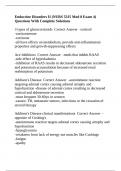
-
NURS 5315 University Of Texas - Arlington -Endocrine Disorders II (NURS 5315 Mod 8 Exam 4) Questions With Complete Solutions
- Exam (elaborations) • 12 pages • 2024
-
- $12.99
- + learn more
NURS 5315 University Of Texas - Arlington -Endocrine Disorders II (NURS 5315 Mod 8 Exam 4) Questions With Complete Solutions

-
N5315 Advanced Pathophysiology Endocrine Core Concepts and Objectives with Advanced Organizers Module 8 Study Guide
- Exam (elaborations) • 24 pages • 2024
-
- $12.00
- + learn more
Endocrine Anatomy and Physiology Analyze the anatomy and physiology of the endocrine system: 1. Examine the production and action of hormones produced by the thyroid, pancreas, and adrenal glands. • Thyroid: ▪ T4 (90%): 1. Released by thyroid gland converted to T3 inside of cell prior to entering nucleus ▪ T3 (10%): 1. more potent, actions are short-lived, present in blood in much smaller amounts than T4 2. stimulates production of the contractile protein a-myosin heavy chain in t...
NURS 5315 University Of Texas - Arlington -UTA Nurs 5315 Mod 6 Pulm & Shock Questions With Complete Solutions
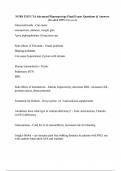
-
NURS 5315 UTA Advanced Pharmacology Final Exam- Questions & Answers (Graded 100% Correct)
- Exam (elaborations) • 8 pages • 2024
-
- $8.00
- + learn more
Glucocorticoids - Can cause: osteoporosis, diabetes, weight gain *give biphosphontate if long term use Side effects of ED meds - Visual problems Hearing problems Can cause hypotension if given with nitrates Flomax (tamsulosin) - Treats: Pulmonary HTN BPH Side effects of testosterone - Edema, hepatoxicity, decreases HDL, increases LDL, prostate cancer, abuse potential Treatment for Rickets - Doxycycline, vit D and calcium supplements Alcoholics have what type of vitamin deficiency? - ...
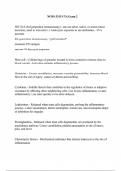
-
NURS 5315 UTA Exam 2
- Exam (elaborations) • 18 pages • 2024
-
- $12.00
- + learn more
HIV EIA (3rd generation immunoassay) - can use urine, saliva, or serum (most accurate), need to wait until 12 weeks post exposure to see antibodies, >99% accurate 4th generation immunoassay- "gold standard" measures P24 antigen can test 10 days post exposure Mast cell - Cellular bags of granules located in loose connective tisssue close to blood vessels. Activation initiates inflammatory process. Histamine - Causes vasodilation, increases vascular permeability, increases blood flow...
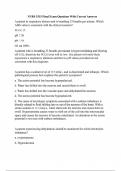
-
NURS 5315 Final Exam Questions With Correct Answers
- Exam (elaborations) • 26 pages • 2024
- Available in package deal
-
- $12.00
- + learn more
A patient in respiratory distress and is breathing 33 breaths per minute. Which ABG value is consistent with the clinical scenario? PCO2 15 pH 7.30 pH 7.45 O2 sat 100% A patient who is breathing 33 breaths per minute is hyperventilating and blowing off CO2; therefore the PCO2 level will be low. The patient will most likely experience a respiratory alkalosis and the two pH values provided are not consistent with this diagnosis. A patient has a sodium level of 115 mEq/L and is disoriente...
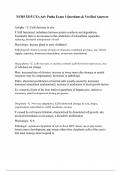
-
NURS 5315 UTA Adv Patho Exam 1 Questions & Verified Answers
- Exam (elaborations) • 67 pages • 2024
-
- $12.00
- + learn more
Atrophy - E. Cells decrease in size P. Still functional; imbalance between protein synthesis and degradation. Essentially there is an increase in the catabolism of intracellular organelles, reducing structural components of cell Physiologic: thymus gland in early childhood Pathological: disuse (muscle atrophy d/ decrease workload, pressure, use, blood supply, nutrition, hormonal stimulation, or nervous stimulation) Hyperplasia - E: cells increase in number, mitosis (cell division) must oc...
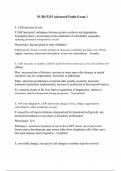
-
NURS 5315 Advanced Patho Exam 1
- Exam (elaborations) • 39 pages • 2024
- Available in package deal
-
- $12.00
- + learn more
E. Cells decrease in size P. Still functional; imbalance between protein synthesis and degradation. Essentially there is an increase in the catabolism of intracellular organelles, reducing structural components of cell Physiologic: thymus gland in early childhood Pathological: disuse (muscle atrophy d/ decrease workload, pressure, use, blood supply, nutrition, hormonal stimulation, or nervous stimulation) - Atrophy E: cells increase in number, mitosis (cell division) must occur, size of c...

$6.50 for your textbook summary multiplied by 100 fellow students... Do the math: that's a lot of money! Don't be a thief of your own wallet and start uploading yours now. Discover all about earning on Stuvia

